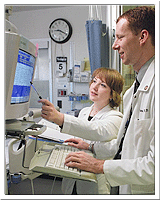Click here to go back.
REPLACING ANIMALS IN CANCER RESEARCH
Animal models have failed to predict or duplicate cancer therapy results for humans. This approach has also failed to provide us with accurate data regarding carcinogenic chemicals.
There are, however, a variety of non-animal methods available. Not only are these methods humane and less expensive, but they have shown to be at least as accurate as animal testing for detecting carcinogens.1
Clinical observation refers to the observation and treatment of patients. Enormous amounts of information are gathered in this manner, all of which is specifically accurate to the disease and the human body. All effective chemotherapy has been through non-animal methods. Medical centers specializing in cancer state, “The most important breakthroughs in cancer treatment have been made in clinical trials.”
During WWI, doctors found that soldiers who had been exposed to mustard gas had low white blood cell counts. They applied this chemical to leukemia and lymphomas, cancers in which these counts are elevated. It worked, demonstrating mustard gas derivatives as being successful chemotherapeutics.
Clinical trials have resulted in less toxic chemotherapies and the ability to spare afflicted organs. Clinical observation encouraged scientists to give cancer patients corticosteroids to destroy cancerous tissues; this approach had failed with animals, but succeeded with humans.
All diagnostic information regarding human cancers was obtained through clinical research. This stands to reason, as human cancers are specific to humans alone. In order to gain knowledge about the causes and treatments of cancer in humans, research must be aimed at humans.
Epidemiology is the study of disease trends within a specific population. In the field of cancer research, epidemiology has revealed causes and preventive measures. In this field of research we’ve learned the potentially cancerous effects of tobacco, alcohol, radiation, lack of exercise, and animal-based diets.
Epidemiological studies are responsible for linking pipe smoking to lip cancer, radiologists with skin cancer, dye workers with bladder cancer, and coal workers with lung cancer. In contrast to scientifically useless experiments inflicted upon hamsters, monkeys and other animals, epidemiology linked glass fibers, arsenic and asbestos to cancer.
It has been demonstrated through epidemiological studies that one-third of cancers and 50% of cancers affecting non-smokers can be prevented by improving diet, particularly reducing meat intake. Smokers and former smokers comprise 90% of patients suffering from lung cancer; secondhand smoke causes an estimated 3,000 lung cancer deaths yearly. Scientists believe that 2-5% of cancers are caused by viruses, 5% are due to genetic factors, and at least 90% are the results of our environment and lifestyle. This is important data, which gives us the power to keep cancer at bay.
Through genetic research scientists have discovered the role of genes in cancer. Some genes activate and deactivate the progression of cancerous cells. Some cancers are due to an inherited predisposition. Others occur as a result of gene mutation. Some genetic damage occurs during pregnancy and later leads to cancer. Genetic research continues to uncover our genetic vulnerabilities to environmental factors, giving us the power to stay healthy.
In vitro research is the most accurate and reliable way to determine a chemical’s carcinogenicity. By using human cells and tissues in a controlled environment, such as a test tube or petri dish, researchers gain valuable and accurate information about the test chemical’s effects on humans. This approach is used to determine chemical effects, diagnose cancers, and even personalize treatments: A patient’s tumor can be grown in a culture and dosed with drugs to determine which are successful against the particular cancer. In vitro tests are predictive and accurate in determining human responses, and therefore immensely safer than animal-based tests.
Technology also provides researchers with progressive, state-of-the-art approaches to cancer research. Technological advances are making it possible for doctors to accurately diagnose specific cancers, and therefore appropriately treat them. With more funding, technology has the potential to interfere with the growth of cancer cells and aid doctors in locating the division of cancer cells.
1. F.K. Ennever, et al., Mutagenesis 2 (1987): 73-8.








